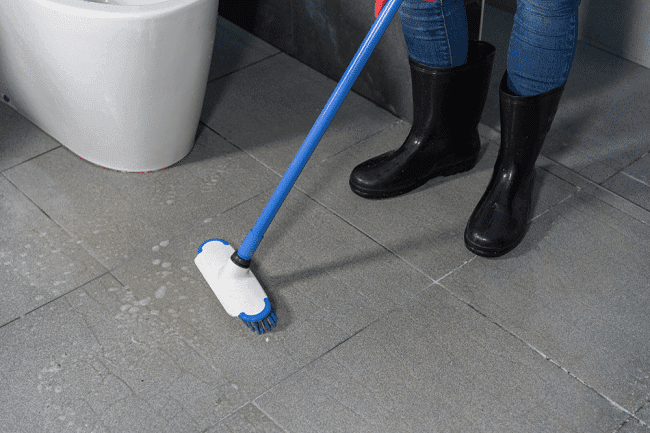When new, your bathroom tiled floor shines and the grouting is beautifully white, contrasting with the color of the tiles. Over time the tiles become dull and sometimes spots of mildew appear. The grout discolors and your tiled floor is no longer so attractive.
On most occasions just mopping the floor is enough but once the above symptoms start to develop, you know it is time for some stronger action, and there are many different solutions open to you.
There are a lot of specialist cleaning products suitable for cleaning your tiled floor, and there are also a number of homemade solutions which work too. So here is how to clean bathroom floor tiles.
First, I would like to address the issue of using vinegar to clean tiled floors. Many people seem to be promoting this idea as a great way of cleaning bathroom floors. However, there is an equal number of experts who believe that vinegar will damage the grout.
Martha Stewart, the well-known cleaning expert, says “Steer clear of lime and mineral scalers AND WHITE VINEGAR as they damage grout”. So, although white vinegar is great for cleaning many surfaces, we will not use it to clean tiled floors.
So having established what NOT to use, now we will take a look at the best ways of cleaning your tiled floor.
You will recognize when your tiles need more than just mopping when you see discolored grout and a hazy film of the ceramic tiles.
First of all, you should vacuum the tiled floor and ensure that all dust and sand are removed. Next, you should mop the floor using a rag or chammy-leather type mop ideally. Sponge mops are not best suited to tiles. After mopping the floor and allowing to dry take a good look at the results.
It Might Be Helpful:
Hazy looking tiles
If your tiles look hazy, this is probably due to a residue of soap left on the tiles. This can build up and cause your tiles to look dull. Remove this film using an all-purpose (non-abrasive) cleaner. Good Housekeeping magazine recommends just a mild detergent solution. This will loosen and remove the soap residue.
Stained Grout
Another common problem that can totally spoil the look of your tiled floor is stained grout.
A product that is acknowledged to be both safe and very effective for cleaning grout is CLR bath and Kitchen Cleaner. This cleaner has a foaming action and if you spray it onto the grout and let it settle for a couple of minutes before scrubbing and rinsing you will see the grout getting whiter as it dries.
This is an industrial-strength cleaner that removes calcium, hard water deposits, soap residue, and dirt. It also has the advantage of being non-toxic and biodegradable. [can be purchased on Amazon]
Mold just loves bathrooms
Your bathroom supplies a fantastic environment for mold to thrive. Mold loves humidity. Not only is mold unsightly, but it causes Asthma attacks, headaches and nausea in some people. Black mold is particularly toxic and cleaning this type of mold should be done carefully, ensuring that spores are not inhaled.
One good mold cleaner is Lysol Hydrogen Peroxide bathroom cleaner. This is a bleach-free cleaning product that will both clear away stains and soap residue and treat the floor against mold at the same time. To use this product vacuum and mop the tiled floor, then spray this cleaner onto the tiles and give it time to bubble.
Once it has stopped bubbling on the wet floor for around 10 minutes, you should simply allow it to air dry. This treats the floor to inhibit mold and ideally, you should repeat this process weekly.
Lysol Hydrogen Peroxide bathroom cleaner contains no bleach and best of all it does not leave any chemical particles on the floor and when it is dry there is a pleasant scent left behind.
You don’t need gloves or any protective clothing to use this powerful cleaner. Additionally, you will be safe in the knowledge that the product has disinfected and killed 99.9% of viruses and bacteria.
Using these products and methods, you will have tackled Soap Haze on tiles, Dirty grout, and mold problems, ensuring that you have thoroughly cleaned your bathroom tiled floor while protecting it from damage caused by abrasive cleaners.
Recommended Resources

Leave a Reply